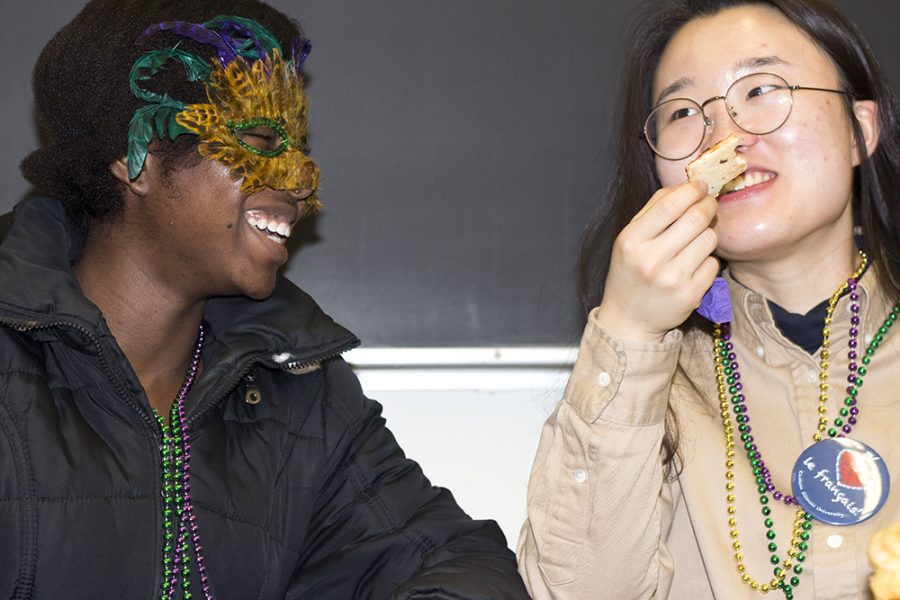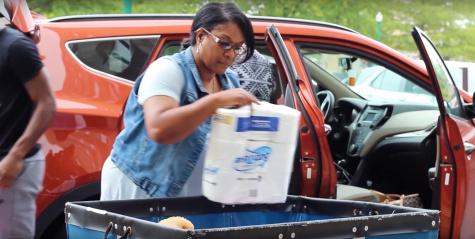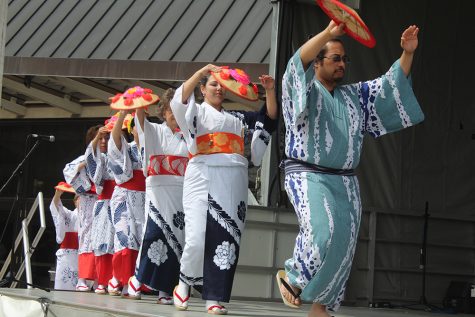French, German clubs celebrate Mardi Gras
Anita Saffa, a junior economics major, and Jane Kim, a junior exchange student from South Korea snack as part of their participation in The Mardi Gras celebration in Coleman hall.
March 1, 2017
Students adorned with masks and beads filled room 1170 of Coleman Hall, and purple, gold and green streamers covered the hallway’s ceiling in celebration of Mardi Gras and Karneval.
The first Mardi Gras festivities in North America took place March 3, 1699 in present-day New Orleans, Louisiana. Over 300 years later, Eastern’s French and German clubs continued the tradition, also known as Fat Tuesday.
Katrina Thompson, a freshman early childhood education major and Spanish minor, said she was told about different cultural events happening on campus through her Spanish class, and she came to have fun.
Thompson said she took French classes in high school, so she was familiar with Mardi Gras. Before arriving to Coleman Tuesday night, she said she hoped there would be king cake, which is traditionally served.
Informational posters hanging in the hallway gave readers facts about traditional Karneval dancers, “Tanzmariechen,” who originated in the Rhine area of Germany. The dancers were based on civilian merchants who, during the Thirty Years’ War in the 17th century, traveled with armies.
The tanzmariechen would perform dance routines, including cartwheels and splits, to polka or march music.
Jane Kim, a junior history major from South Korea, said the Mardi Gras celebration is bigger than what she thought and more interesting.
Another poster in the hallway described a variety of traditional fried foods like donuts, or “krapfen,” which were filled with jam, vanilla cream or eggnog.
Fried potatoes, bratwursts, meat patties, spiced wine and potato pancakes were among the traditional food prepared and eaten in Germany during Karneval.
In the Middle Ages, krapfen were only available before Lent, because people used up the winter stores of lard before it could spoil.
At the French and German clubs’ celebration, there was a table full of a mix of traditional and American foods. Krapfen, king cake, pizza and popcorn were set up for guests.
The king cake was decorated with purple, gold and green icing. The color purple represents justice, gold represents power and green represents faith.
Kate Rehwinkel, a freshman marketing major and German minor, said she thought the event was fun and brought along her friend Kayla Messamore, a sophomore special education and early education major.
Messamore said she celebrated Mardi Gras in the past. In her piece of king cake, she found a small, baby Jesus figurine inside. That meant she was the one known as “queen” for the day.
During medieval times and the Renaissance period, people wore masks and costumes to hide their identity and class status. In today’s society, that meaning has faded.
Students were able to decorate their own masks with glitter, sequins and feathers.
The packed room of students played jeopardy based on questions about French Mardi Gras and German Karneval.
Tanner Skym, president of the German club and junior history major, made the jeopardy game. It included questions under categories like food, symbols, clothing and celebrations around the world.
Skym said the German and French clubs celebrated Mardi Gras and Karneval last year together as well.
Kennedy Nolen can be reached at 581-2812 or [email protected]













































